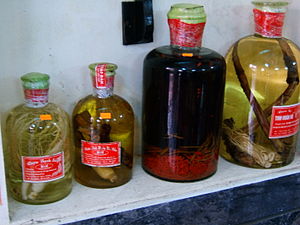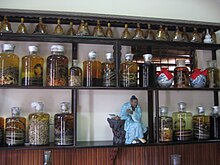Rượu thuốc
This article has multiple issues. Please help improve it or discuss these issues on the talk page. (Learn how and when to remove these messages)
|



Rượu thuốc (lit. 'medicinal liquor') or rượu dân tộc (lit. 'traditional liquor') is a kind of Vietnamese distilled liquor (rượu) with herbs and medical animals, considered by traditional medicine as good for health. This drink consists of herbs or animals soaked in alcohol as a folk medicine cure for diseases in Vietnam. In Vietnam, rượu thuốc is widely believed to help drinkers improve their health and virility.[1]
Production
[edit]

A popular type of rượu thuốc is snake wine (rượu rắn) for its placebo ability to cure multiple diseases including far sightedness, hair loss, back pain, digestive problems, fertility problems and even leprosy.[2] The general principle of preparation is soaking venomous snakes in alcohol, where ethanol will denatured protein-based snake venom.[3] In one method, the snakes can be soaked, or macerated in wine along with other ingredients with medicinal properties in Chinese medicine including ginseng, scorpions, Ming ariala (Đinh lăng), Fallopia multiflora (Hà thủ ô đỏ), Morinda officinalis (Ba kích) etc to remove odour. Another method of preparation is extracting blood and bile from a snake and its gallbladder and mixed with rice wine or grain wine to be consumed immediately.[4] Rice wine mixed with bile is also called rượu mật.
Consumption
[edit]

Rượu thuốc is typically drunk before a meal in a shot glass or thimble size cups, for only one or two shot glasses for health benefits.[5] It is also used in drinking sessions and as souvenir gifts from a trip, as each region has its own variety of rượu thuốc.[6] It is believed among Vietnamese that drinking rượu thuốc may cure or alleviate several diseases (but not the ones caused by viruses or bacteria).

In addition, rượu thuốc has external use on the skin including soaking, massaging, covering, and washing areas with pain to treat arthritis, sore muscles, hives, and so on.
Controversies
[edit]There have been cases where unregulated use of producing and consuming homemade rượu thuốc led to alcohol poisoning and skin allergies when used as topical treatments against acne.
Alcohol poisoning from rượu thuốc happens mainly for two reasons, either the rice wine used did not come from a proper facility and contains methanol, a toxic alcohol used in various households and industrial agents,[7] or the ingredients used in the maceration process is toxic for consumption (i.e. Gelsemium elegans (Lá ngón), neglectful preparation of coucal (Chim bìm bịp) in rice wine without removing its viscera and fur containing parasites).[8]
Rượu thuốc is also a used for skincare purposes to combat acnes. The strength of the alcoholic content in rượu thuốc is corrosive to the skin, especially for sensitive skin, causing allergy reactions, skin irritations, damaging skin cells.[9]
See also
[edit]References
[edit]- ^ "The Last Days of the Mekong Snake Hunters". 9 August 2016.
- ^ "Snake alcohol in Vietnam". Authentik travel. Retrieved 2023-06-19.
- ^ "The Snake Wines: How about with a venomous snake in the mix? - Alcoholic Science". 2010-12-22. Retrieved 2023-06-19.
- ^ "Snake alcohol in Vietnam". Authentik travel. Retrieved 2023-06-19.
- ^ "Medicinal Rice Wine - Rượu Thuốc | Viet Tracks". 2018-12-05. Retrieved 2023-06-19.
- ^ "The intoxicating world of Vietnam's rice wine culture". Your vietnam travel guides and tips| Vietnam travel blog. 2010-10-30. Retrieved 2023-06-19.
- ^ Ashurst, John V.; Nappe, Thomas M. (2023), "Methanol Toxicity", StatPearls, Treasure Island (FL): StatPearls Publishing, PMID 29489213, retrieved 2023-06-19
- ^ Nhân Dân Post (2023-01-30). "Cảnh báo ngộ độc do uống rượu ngâm không rõ nguồn gốc [Alcohol poisoning due to consumption of medicinal wine made from wine with unknown sources]". Báo Nhân Dân điện tử (in Vietnamese). Retrieved 2023-06-19.
- ^ https://www.facebook.com/WebMD. "Rubbing Alcohol vs. Hydrogen Peroxide". WebMD. Retrieved 2023-06-19.
{{cite web}}:|last=has generic name (help); External link in|last=
